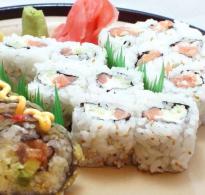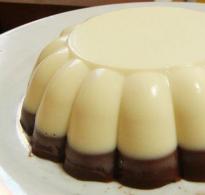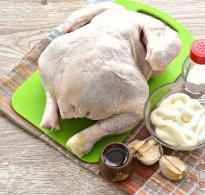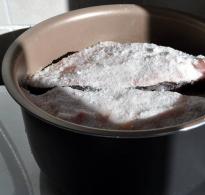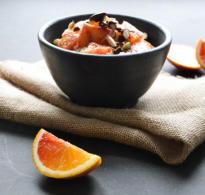Marbled beef - a delicacy among meat products - Intras-Krasnoyarsk. Japanese marbled beef (kobe meat)
This is a special product characterized by the presence of many layers of fat that make the meat very juicy and tender. The tenderloin looks unusual - the pink color is penetrated with white stains, which forms the marbling of the meat. During cooking, fatty layers are melted, filling the dish with juice, due to which it acquires a unique softness and aroma. The most expensive meat is the one with the maximum amount of such layers.
What is marbled meat
More often this term is used for beef (beef), but it can also be used for pork, horse meat (Yakut horse tenderloin). Marbled meat is a piece of red fillet that contains a sufficient amount of intramuscular fat, arranged in layers, and resembles a marble pattern. In young cows and bulls, marbling is rare, since in veal fat develops first in the heart, kidneys, near the pelvis (under the skin). Only after the animal has matured do fatty fibers begin to form in the intermuscular space and directly inside the muscles.
What is the difference between marbled beef and ordinary
There are two main types of cows - beef and dairy breeds. The latter are designed to give milk, which is what they do all their lives. When a cow of this breed ages, it is allowed to be slaughtered. Such meat is sold in markets and supermarkets. Beef cows are bred specifically so that after a certain period of fattening (grain or grass) they go to slaughter. These animals are genetically predisposed to the growth of intramuscular fat, which gives the beef a marbled pattern.
Meat streaked with fat is very soft, juicy and tender. Marble veal does not come to store shelves often, it is highly valued, since it requires strict adherence to the cultivation technology. Marbled pork, like beef, is considered a delicacy due to its small share in the total volume of meat products produced, while the demand for it is increasing. Selected beefsteak with fat layers is cooked very quickly - young meat takes only a few minutes.
How marbled beef is grown
On the territory of the Russian Federation, the selection of beef cattle is only gaining momentum. One of the leaders of this agricultural segment is the Zarechnoye group of companies, which produce products under the Primebeef brand. This marbled meat is obtained from Aberdeen Angus bulls, which are grazed and fed in the ecologically clean region of the Kaluga and Voronezh regions.
Throughout the year, animals live in an environment close to natural, free-range they eat meadow grasses, after which they are transferred to feedlots. The manufacturer has been giving them a special multi-component cereal mixture based on wet corn for six months. As a result, high-quality marbled meat gets on the shelves, from which juicy steaks are made. In order to fully develop the taste of beef, it undergoes a two-week wet maturation before being delivered to stores.

Factors affecting marbling
This term defines the presence of intramuscular fat in meat. Evaluators look at the volume and distribution of fatty fibers in the longissimus dorsi muscle in the section between the 12th and 13th ribs. The degree of marbling is one of the main criteria for determining the category of product quality. This indicator depends on the breed, genetic data of the animal, selection. Beef cattle (Wagyu, Aberdeen Angus, Shorthorn, etc.) and dairy breeds (Holstein, Jersey) have more adipose tissue in their muscles.
Marbled meat will not work without proper nutrition. The longer the cattle are fed with a high-calorie feed, the more chances are to get the highest possible beef quality indicators, but at the same time a much smaller amount of marbled tenderloin will come out (the ratio of lean meat to marbled meat changes in favor of the former with the age of the animal). Feeding cows and gobies with large amounts of grains such as corn and barley will change the live color from yellow to white. In addition, the chances of obtaining higher quality in accordance with accepted standards will increase.
Lack of physical activity is a factor that also affects the cultivation of marbled meat. Gobies and cows that have grown in cramped stalls have softer meat than animals that were allowed to walk a lot. For example, animals restricted in movement easily accumulate fat inside the muscles, their tenderloin becomes soft. Free grazing cattle eat a lot of fiber-rich grass (instead of grains) and put a lot of stress on the muscles when walking, so the muscle tissue becomes dry.
The generally accepted technology for raising and feeding livestock for obtaining marbled meat in the world is feedlots, which are areas for feeding with high-calorie feed for at least 4-5 months before slaughter. The initial growth time of the animal falls on free grazing. The breed of gobies Kobe is fed milk until six months of age, after which they are transferred to pasture, where they grow practically without human intervention on free grazing.
The grown-up cattle are transferred to individual rooms with soundproof walls and suspended on reins so that they cannot move, but also do not lie down, since then the muscles will be under tension to evenly layer the tissues with fat. At this time, the bulls receive selected grain and high-quality beer (the latter is needed to improve their appetite). Such a diet enhances the deposition of fat. The average standard for grain feeding is 200-300 days. In order for the fat to penetrate deep into, forming thin layers in the muscles, the bulls are periodically given vibration massage.

Types of marbled meat steaks
Beef steaks are an expensive dish, the meat for which is taken from the best parts of beef carcasses. Only a tenth of the entire cow is suitable for their preparation. Modern cooking distinguishes the following types of steaks, the names of which indicate the place of the carcass from which the meat was cut:
- club steak - cut from the back at the thick edge of the longest dorsal muscle, has a small rib bone;

- ribeye steak - taken from the subscapularis of the animal's body, has a large amount of adipose tissue;

- tebone steak - meat on a T-shaped bone, cut at the border between the lumbar and dorsal parts near the thin edge of the longest muscle of the back and the thin edge of the tenderloin, due to which it consists of two different types of fillets (New York bone and filet mignon) ;

- strip-loin steak - taken from the lumbar strip, without bones;

- porterhouse steak - cut from the loin of a cow at the thick edge of the tenderloin;

- roundrumb steak - tenderloin from the upper part of the hip;

- sirloin steak - marbled meat that is cut from the loin at the head of the tenderloin;

- Scritt steak is a delicious, expensive piece from an animal's diaphragm;

- filet mignon - a transverse thin section of the central region of the sirloin with the most tender meat;

- tornedos - small slices from the thin edge of the central part of the tenderloin, which are used to make medallions;

- chateaubriand - the thick edge of the central part of the tenderloin, which is fried whole, not much different from filet mignon, but served not standing on a plate, but laid out in length.

How to cook meat
To fry marble fillets on a grill or pan, use a tenderloin from the rib portion, which is characterized by a high degree of fat content and juiciness. This type of dish in restaurants is appreciated more than others. Steamed beef is not recommended. When preparing a steak, it is better not to rush, otherwise the inside of the steak will remain soggy. The optimum temperature for marbled beef according to the classic recipe is 160 degrees.
Marble steaks are an absolutely exceptional product in the world of meat, highly appreciated by gourmets around the globe. What is marbled beef?
Marbling of meat is determined by fat layers located in a piece of meat and muscle fibers. A high-quality steak is distinguished by a high marbling, while a lean cut is, on the contrary, small. The fat should be pure white and evenly distributed throughout the steak! It would be a mistake to claim a steak to be highly marbled based solely on the presence of a large chunk of fat on the side.
Most are located in the dorsal part of the animal, the muscles of which receive minimal stress during its life, if compared, for example, with the legs or shoulders. All calories, which are rich in the diet of a bull, accumulate here.
When preparing marbled beef, the fat inside is melted, making the meat tender and flavorful. These layers of fat provide the recognizable texture of a high-quality steak and its unforgettable taste.
Without the marbling, our steak would have come out dry. However, even with high marbling, it is important not to overcook the meat in order to preserve its juiciness. The best way to cook a steak, which we talk about often, is in a preheated cast iron skillet. Another method that we like is to quickly fry at a high temperature, and then bring it to the desired degree of doneness in a preheated oven.
№ 1
Grilling season is the most wonderful time of the year when the aroma of juicy steaks spreads throughout the area. Now is the time to uncover the secrets of marbled beef selection that will make you the barbecue king.According to the US Department of Agriculture classification, beef meat is divided into three categories by marbling: Prime, Choice and Select... Qualified specialists with the help of modern equipment take into account several factors at once that determine the category of beef, depending on the distribution and number of marble veins.
The correct choice of marbled beef guarantees the chef's success with the guests. Frying methods differ depending on the amount of fat in the piece. According to the classification we mentioned, the Prime category is assigned to the most marbled steaks, followed by Choice. The Select category assumes low marbling. This type of meat can be grilled, but must be gentle if you want to keep the meat juicy and tender. Prime steaks should be roasted over high heat until medium rare-medium well for excellent results. And cuts such as tenderloin or top blade remain tender and with a low degree of marbling.
Why are we telling you about the USDA meat classification? In fact, no political motives. The USDA grading is generally accepted by the top butchers around the world. Wholesale buyers, restaurants and even governments are guided by it when purchasing marbled meat. We are also guided by her to supply you with beef, in the quality and taste of which you can rest assured.
№ 2
Marbled meat is a special type of red meat that has been nicknamed "marbled" for its pronounced fatty layers.Marbling is achieved through selection. Cattle breeds such as Angus, Hereford, Murray Gray, Short Horn, Wagyu, and dairy breeds such as Jersey, Holstein Friesian and Brownwiech have significantly higher marbling than other breeds.
The marbling of beef also depends on the feeding. Grain-fed bulls (corn or barley) change the color of the fat from yellowish to white, and increase the chances of obtaining a higher marbling class according to the USDA peer review. For example, a rib eye cut is compared with reference templates, and based on this, a certain category is assigned to it.
Marbling affects several factors, in particular the texture and color of meat.
The physiological, not biological, age of the animal is taken into account. The fact is that the biological age of a goby is almost never known for sure, so experts use such a parameter as biological maturity. The indicators are the condition of bones, cartilage, color and structure of the ribeye muscle.
The United States Department of Agriculture's worldwide grading system has eight different marbling categories: Prime, Choice, Select, Standard, Commercial, Utility, Cutter, and Canner.
Prime- the highest degree of marbling of beef. A selection of the best restaurants and luxury supermarkets. Choice is also a popular choice for many meat eaters. Select is a more budget-friendly option, but just as nutritious. For these three categories (as well as for the Standard category), young bulls less than 3 years old are used.18.11.16
Marbled beef is perhaps the world's most famous meat delicacy. It is called "marble" because on the cut it very much resembles a stone streaked with veins. This effect is achieved due to the presence of thin layers of fat in the muscle tissue, which make the meat taste surprisingly juicy, light and tender. Such meat is obtained from gobies raised using a special technology. This technology consists in intensive feeding of the animal, during the last three to four months before slaughter, exclusively with grain, with its complete restriction in movement. The source of high quality marbled beef is only the meat of young gobies. This allows for a low content of connective tissue, which gives the beef more tenderness.
Especially appreciated is marbled beef obtained from gobies raised according to the old Japanese technology "Kobe". According to this technology, at first the young goby is walked for some time in clean meadows. He is then kept suspended from the ceiling on reins in a room with soundproof walls, fed with rice and soldered with beer. The process is accompanied by the continuous sound of classical music. And so that poor animals do not have bedsores and shortness of breath, they are daily vibrated. When the bull reaches the desired weight, it is slaughtered. The meat turns out to be very tender, and the veins do not look like stripes, but a real marble pattern.
Cooking marbled beef
"Marble" meat as a species appeared in Japan in the 1860s, so the classic recipes for its preparation came to us from there.
This type of meat has 120 varieties, each of which bears the name of the village in which it is produced. For example, "Kobe" is a variety from the capital of Japanese "marble" meat - the city of Kobe. There is even a saying in Japan: "You don't need to have teeth for Kobe meat."
Usually a Japanese chef prepares marbled meat right in front of the visitors on a large stove - teppaniyaki, or hibachi-table, as the Americans call it. These are special brazier tables located next to the tables. The meat is fried in vegetable oil with the addition of sesame seeds and spices. The rest of the details are cook's secrets.
Shabu-shabu (boiled thin pieces of meat, vegetables, noodles) and sukiyaki, whose history goes back 150 years, are made from "marbled" beef. When the Japanese still ate little meat, they lit a fire near the house to cook it, and to fry the meat, they used a shovel (in Japanese - "bitches"), and they call any roast "yaki". This is how the name of this dish arose.
In restaurants, you can most often find sukiyaki nabe - boiled marbled meat with bean curd, vegetables, noodles and a raw egg. For this dish, the chef only prepares the ingredients, and the guests themselves cook thin slices of beef in a saucepan with water or weak broth. The finished meat slices are dipped in a small bowl with a beaten raw egg. While everyone is eating, the cook adds various spices to the sauce as needed. If his taste gets too pungent, he adds more sake or water.
The most important criterion for evaluating such meat is its “marbling”, that is, the quality of the intermuscular fat layer. “If we accept the division into categories A and B, in each of which the marbling is indicated by a number from 1 to 5 (A5 is the top of the top), then in Moscow restaurants you can find meat of categories A2 and A3, rarely A4,” says Gennady Kim. “Its purchase price is from € 140 to 180 per kg.” However, Wagyu bulls are also bred in other countries. “Wagyu beef of the penultimate quality level can be found, for example, in Australia,” says Anton Lyalin, co-owner of Global Foods. "But the highest level is possible only in Japan, because the methods that the Japanese use to make it are prohibited in other countries." So, when looking for real meat from Kobe or Matsusaki in Moscow, it is better to start with expensive Japanese restaurants such as Sumosan or Seiji ..
Depositphotos.com/@ venge.mail.ua
The most expensive meat in the world is marbled beef. This is a product for real gourmets, which is often placed on a par with such delicacies as black caviar and foie gras. What's so unusual about a simple piece of beef? Why is it classified as a premium product?
This meat delicacy got its name for its special appearance. Each piece of marbled beef is as if permeated with a thin web of adipose tissue, which form a whimsical pattern reminiscent of a natural stone pattern. Delicate pink meat with ornate white streaks really resembles marble - as if an artist had worked on it. In addition, the product is appreciated for its amazing taste, juiciness and malleability to gastronomic processing.
In the process of heat treatment, the snow-white layers of fat inside the marble piece of meat dissolve, literally melt, like snow in the spring sun. Thanks to this, marbled meat is filled with juice and becomes tender. The thinner the fatty patterns and the more of them, the higher the indicator of the so-called "marbling". This means that the price is higher and the quality is better. Professionals distinguish three categories of marbled beef meat:
- Prime- the highest grade,
- Choise- selected meat,
- Select- regular marbled beef.
The marble pattern on the meat is the result of the hard work of the farm workers. To get premium beef, you need to create special conditions for keeping bulls. For six months they are on a dairy diet, then graze in ecologically clean meadows. Juicy green grass and fresh air do their job: calves gain weight well. Then the matured animals are fed grain, their cereal diet - wheat, corn and barley. At the same time, they are not subjected to physical stress, which is very important for obtaining meat without coarse muscle tissue.
According to the classical rules of fattening calves for the production of marbled beef, animals, in addition to a unique feeding system, are also supposed to be sealed with beer to improve their appetite and a special vibrating massage accompanied by calm music. It is in such conditions that the inhabitants of Japanese farms are kept. By the way, it is this country that is a pioneer in breeding cattle breeds that produce marbled beef. There, such meat is called food, for the use of which "you do not need to have teeth." It is not surprising that in such conditions, oriental gobies produce beef that melts in their mouths.
Classical music is not played on our farm, but we know how to get marbled meat no worse than the Japanese. Historically, in our country, calves were raised using a unique technology with the light hand of Nikita Khrushchev. He was so impressed by the taste of the marbled beef steak that he tasted in the United States that a special farm was soon equipped to feed animals using this method. For a long time in Russia this meat was a delicacy for the highest circles. And only in recent years, premium beef has begun to be served in restaurants.

It is quite possible to prepare a royal dish at home. You just need to choose marbled beef meat of excellent quality - environmentally friendly and fresh.
Unforgettable taste sensations are guaranteed to you!
Tell - Ivan Shishkin, 4 March 2013
1 14 3 121498
Marble meat is considered to be a reference product in terms of quality. Special beef cattle breeds and carefully selected feeding regimes give the perfect combination of muscle fibers and fatty inclusions in the meat, which ensures the standard taste of the finished product. Ivan Shishkin, chef of Moscow restaurants Delicatessen and Tapa De Comida, believes that all this is nothing more than a beautiful marketing story.
Ivan Shishkin
About juiciness and fat content of meat
I am not against marbled meat as a food product. Such meat is popular in the market, it is in demand, and it is eaten. Another thing is that the marbling of meat in no case should be the leading quality criterion.
Please note what is ordered in restaurants today. A grown man, a healthy wild boar walks into a restaurant and orders a tenderloin - the most textureless, tender, tasteless meat. In my opinion, it makes no sense to fry the tenderloin - it's cotton wool. However, men order Filet Mignon or Chateaubriand, which 15 years ago were considered dishes for fragile girls.
This is due to the emerging marketing situation. After the introduction of intensive livestock technologies, it turned out that cows raised immobilized in cramped stalls (feedlot) produce very soft meat, due to the fact that their muscles do not undergo such stress as those of "freely walking" cows. There is a lot of this soft meat on the market, and the people who sold it managed to convince everyone that it was a premium product.

Marbled beef counter in Japan.

Japanese Wagyu bulls are given a massage, beer is added to the diet for appetite, and they are allowed to listen to classical music.
To explain the higher price, they began to say that this meat is "marble" and that it is more tender and juicy, which, of course, is not true - the fat content of the meat does not mean juiciness. Although there is some truth in this statement - intramuscular fat has a soft structure. And its melting point is about two degrees lower than that of skeletal fat. Intramuscular fat imparts a certain softness to the finished product.
Where did marbled meat come from?
By and large, the myth of the elitism of marbled meat arose by chance. The technology of "marbleizing" meat appeared at the turn of the 19th and 20th centuries in Japan. When the Japanese just brought cows to the islands (this happened in the middle of the first millennium BC), the animals developed completely independently, the breed did not interbreed with anyone, that is, it was a monostado, genetically homogeneous, pure. Then cattle were used as a draft force, they were not raised for meat.
Raising cows for meat in Japan began in the middle of the 19th century. And there is very little space for this on the islands, so the animals were herded into these cramped stalls. And the cows began to grow fat quickly. More precisely - not cows, but bulls - it is bulls that are raised for meat. Although now there are several farms engaged in the production of exclusively cow meat.
The marbling of meat is a consequence of the body's natural ability to accumulate fat between muscle fibers. But this property manifests itself only in captivity. Animals that grow in free conditions almost never accumulate fat, that is, wild animals will never give marbled meat, because they are constantly on the move, get their own food and do not get an excess amount of calories.
To obtain marbled meat, the first thing to do was to immobilize the animals, place them in a stall and transfer them from a natural herbal diet to a diet containing a large amount of carbohydrates, namely, a cereal diet. Such a diet is unnatural for a cow - her gastrointestinal tract is adapted for repeated grinding, fermentation and re-fermentation of coarse cellulose feed. And there is much less cellulose in grain than in grass, so fermentation occurs in a completely wrong way - flatulence occurs in animals.

Chianina bulls are the largest on the planet in size and weight

Florentine steak is often ordered for a large company.
When the Japanese learned to make marbled meat, this knowledge remained within their culture for a long time. The rest of the world was content with cows that roamed freely and were driven over great distances.
Today, meat growing technologies have led to the fact that you can get not only marbled beef, but also mutton, and pork, and even horse meat. This is rather strange and rather curious. In general, I think that marble ducks will appear soon.
Marbling of meat is not a quality criterion
In Italy, the famous breed of tall bulls, the Chianina, are grown. These are the largest bulls on the planet in terms of size and weight. An average three-year-old goby weighs one and a half tons, its height at the withers is up to two meters. Previously, they were used to plow and haul carts with loads. This breed is generally not prone to marbling. But, nevertheless, the most famous Italian specialty - Fiorentina steak - is prepared from a huge cut of the Chianina's lumbar part. Such a steak cannot be eaten alone - this is a romantic dinner for two, or even for the whole company. Once I witnessed how a Florentine-style steak was successfully divided between eight adult men, who fell away from it too much.
So, this steak - a cult meat specialty - does not contain marbling at all. That is, it turns out that the quality criteria are made up of other components:
- the ratio of meat and fat in the carcass;
- aging, cold maturation;
- of course, the breed. Different breeds have different sizes of muscle fibers. Fibers can be long or short, thin or thick - this is what the taste of the meat depends on and from this you get soft meat, and not because of the greasy veins.
Some breeds are more prone to intramuscular fat accumulation, others less. All known angus are prone to marbling. But the same Angus gives great taste and fantastic quality meat if it lives in free-range conditions. Its carcass contains the finest skeletal fat, so yellowish in contrast to the bright white intramuscular fat. This fat stores carotene from plants. That is, there is already some benefit in this. But this fat is more refractory.

A bull kept on a grain diet - fat folds are clearly visible.

A chef at BLT Steak (Miami) demonstrates a piece of meat that will be used to make a premium steak.
If the animal has walked a lot, overcame long distances, then, of course, its meat will be denser. But such meat can be cooked in a completely different way. You need to put the steak on the grill, turn it over, cut off the toasted parts from it - this can take several hours.
So it is customary to cook the meat of gobies from Latin America, who do not just walk, but they are specially chased, like the Sidorov goats, they are running. They have a very high-calorie diet. In season, they eat good food in open meadows, accumulate protein mass well, and there are a lot of legumes enriched with nitrogen in their diet. Their meat tastes great.
Be a man - chew meat!
In my opinion, marbled meat is truly a premium product. It is soft, expensive and makes life easier for everyone: producers, sellers, cooks, and buyers.
It is profitable for a producer to raise cows in cramped stalls - it is much more expensive to keep them on free grazing. And the resulting product is sold more expensive than the meat of cows grazed in the wild. The sellers are happy too. From a business standpoint, it's brilliant. From the point of view of humanity and attitude to nature - a complete disgrace.
Now the eggs of chickens are very popular, which were not kept in poultry houses, but freely walked. These eggs are really tastier and people are happy to buy them. But keeping chickens free to graze is cheaper than cows. With poultry, it is possible to get away from intensive livestock raising, with cattle this will not happen in the near future.
Now it makes no sense for a chef to try to convince a client who already has a strong stereotype that marbled meat is the best product. It's even more convenient for a cook - now it's enough to just throw a piece of meat on a hot grill, heat it on both sides, no matter how many times you turn it over, flavor it and give it away.
For the consumer, everything is also very easy - he gets a deliberately soft piece of meat, he eats it without encountering any resistance: there is no need to chew - it melts in the mouth by itself. And there is no longer a question of where the beef taste is, where it all comes from, what is it all for.
It is not softness, not fatness and not texture that is primary, but taste! But it is not in soft meat - it is, in fact, lost. Wanting to make it easier to work with a knife, fork and teeth, we have lost the real taste of meat.
“Growing marbled beef is easier than non-marbled beef. The cows stand in their stalls, eat high-calorie food, they don't need a place to graze, they don't need anything. "
Although in our time, when everyone's teeth are in order, dental care has become available, it would seem, let's make normal meat! We will chew it and get pleasure from it, feel the juice that penetrates into our mouth with every chewing movement and enjoy. But no - everyone wants to knead it with their teeth and swallow it without chewing.
But the premium product, which is marbled meat, is a delicacy that cannot be eaten every day. Everyday food should be simple and truly delicious. But we continue to live with the imposed stereotype that marbled meat is tastier.
Making marbled meat is easy!
In fact, as strange as it may seem, growing marbled beef is easier than non-marbled beef. The cows stand in their stalls, eat high-calorie foods, they don't need a place to graze, they don't need anything. Take out the manure, bring the fodder - that's all. It's like a chicken coop, they are locked in their own dung.
Japanese producers say that they even turn on music to make the cows calmer, and they also massage them. So the tradition of massaging cows did not go from the fact that they wanted to make the meat more tender and softer. After all, massaging a cow is nonsense! She can be hit by a boxer and she won't feel anything. She has thick skin and the highest pain threshold. But in fact, they massage the cows from crowding. Cows in narrow stalls are simply immobilized, massage creates the illusion of movement.
This immediately raises the question of a double standard. There are organizations all over the world that are trying to ban something - foie gras, for example. But raising poultry on foie gras is a common family farming business in many countries of the world, of course, most of all in France. The question is, how is forced feeding of geese different from the forced transfer of an animal to high-calorie food?

Premium product of the Iberico trademark.

Florentine steak is the most famous Italian specialty.
Moreover, the cow cannot be tube fed. Her digestion is so arranged that she cannot fill her stomach up to her throat. She has a traffic of ruminant mass - both down and up, she periodically regurgitates part of the intestine and chews again, then this mass is fermented. It is impossible to force a cow to eat by force, but you can stimulate appetite, for example, add beer to her food so that she insists, incubates, accumulates excess fat.
Wet aging is another myth
In the entire history of the "marbleization" of meat, there is a grain of deceit. I will say more - with proper steak cooking technology, in blind testing, meat in the “select” category in the American grading system does not differ from meat in the category not marble at all. I think that the average consumer will not notice the difference at all if it is good aged meat that is already ripe and has a border of skeletal fat and fermented in the refrigerator.
Fat as such has no taste, it is only a carrier of taste. Taste of beef, which is in the meat and without marbling.
How to cook the meat of a free-grazing cow
If we talk about cooking a steak, you need to remember: the quieter you drive, the further you will be. This rule applies to any food preparation process.
5% of dishes benefit from being prepared quickly, while for the vast majority, slow cooking is important, and steak is a prime example. It is enough to throw a piece of marbled meat into a frying pan heated to 220-250 ° C and turn it a couple of times. It seems ready outside and warmed up - it's time to serve.

Marbling Angus goby.

Free-grazing Angus steak - no intramuscular fat.
Not at all the same steak, cooked on a slow grill at a temperature of about 160 ° C. If you cook it on a slow grill, turn it over often, heat it evenly on all sides, so that not only a crust forms, but the piece is still cooked inside. Do not allow muscle fibers to shock, shrink and thereby squeeze all the moisture out of yourself. If there is a rim of fat, it must be left on while frying - this is a strictly necessary condition for the taste to concentrate. There is no desire to eat fatty meat - this crust can be cut off, but only after the meat is completely cooked. Then you get quality, taste and texture really comparable to marbled meat.
Why marbled meat doesn't bring happiness
I guarantee that free-bred gobies will have more beef flavor. This is exactly what I'm looking for in meat. I am looking not just for a protein product that is easy to put in your mouth and chew, but I am looking for a taste. I look for the taste of beef in beef, and in pork for the taste of pork. Many people say that pork has no taste, but this is not so: pork has its own pronounced taste, which you like or not - just like lamb and goat meat. The taste of any meat depends on the gentle post-processing process.
There is no happiness from this marbled meat. It is important that the meat is clean, well fed, properly slaughtered, properly aged and cooked according to the rules.


